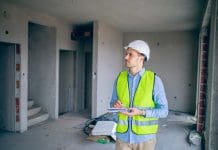The cementing of the Building Safety Act will see April 2024 marked as a significant month for UK construction, as Bal Manak, construction partner at Square One Law, explains
April 2024 will be a month to remember for the UK’s construction industry. While the Building Safety Act 2022 came into force on 28 April 2022 and was brought into force via numerous regulations, as of 6 April 2024, any building work that was previously covered by the transitional provisions—but not started by that date—will now be subject to the new regime.
Higher Risk Buildings (HRBs)
For a building not to be deemed as a higher-risk building (at least 18 metres or 7 storeys high with at least 2 residential units) and remain under the control of the local authority as the building control authority, works must have been “sufficiently progressed”.
For a new HRB, this means when the pouring of concrete for the permanent placement of the trench, pad or raft foundations or the permanent placement of piling for the building has started. For an existing building, it is when the work starts or if a material change of use when work to effect it has started.
Moreover, for works which were the subject of an initial notice issued before 1st October 2023, the approved inspector must have registered as a building control approver before 6th April.
If this has not been done, the works being conducted on a HRB will be subject to the new regime.
The BSR also expects all HRBs to be certified within five years, meaning they will all need to be re-assessed every five years to ensure the ongoing management of safety.
The dutyholders regime
Another of the new requirements under the Building Safety Act is the introduction of the dutyholders regime (England only).
This requires dutyholders to be identified in the procurement design and execution of building work. This is not just for HRBs. Dutyholders are clients, principal designers, designers, principal contractors and contractors.
Dutyholders are required to collaborate and communicate with one another to plan, manage, and monitor their work properly.
There is a requirement for the client to appoint a principal designer and principal contractor for each project subject to building regulations.
It is not limited to HRBs and may include domestic projects. It is possible that the parties currently undertaking the roles of principal designer or principal contractor under the CDM Regulations can also take on a dual role of principal designer and contractor under the Building Safety Act, but they must show they are competent to do so, and it is the client ultimately responsible for ensuring they appoint competent persons.
In order to show competence, the Principal Contractor and Principal Designer must show that they have the “skills, knowledge, experience and behaviours” necessary to fulfil the role. If the client fails to appoint these parties, then it is responsible for fulfilling those roles.
When carrying out design work, designers must also take all reasonable steps to ensure the design (if the building is built in accordance with the design) complies with all requirements. Contractors have a similar standard but it is not subject to reasonable endeavours so it is a stricter obligation to ensure the building work they carry out is compliant with all relevant requirements.
The Principal Contractor have additional obligations – they must plan, manage and monitor the building work during the construction phase, and co-ordinate matters relating to the building work comprised in the project to ensure the building work complies with all relevant requirements.
The Principal Designer must plan, manage, and monitor the design work during the design phase and coordinate matters relating to the design work comprised in the project so that all reasonable steps are taken to ensure that the design is such that if the building work to which the design relates were built in accordance with that design, the building work would comply with all relevant requirements.
Building Safety Regulator (BSR)
Under The Building Regulations Etc. (Amendments) (England) Regulations 2023, from October 2023 the Building Safety Regulator will oversee the building control process approval for all HRBs.
The HRBs will have to pass through each of the 3 gateway points in order to be approved. Applications will automatically lapse after 3 years if works have not commenced.
For Gateway 1 (pre-construction) clients must submit a safety case report assessing the building’s safety during design and construction. The BSR will review the report and assess the client’s competence to meet safety standards.
For Gateway 2 (before and during construction) building work on HRBs can only start after approval from the BSR, otherwise it will be a criminal offence. The client will notify the BSR when it can carry out inspections, which can include taking samples and opening up works.
The BSR will be assessing the fire safety systems and structures, i.e. cladding and external wall systems.
Any changes from the application must be notified to the BSR and material changes must be approved. The BSR has 12 weeks to sign off a new building and 8 weeks for existing buildings before construction can commence. The client is expected to provide a detailed safety plan.
Gateway 3 will be achieved on completion of the building work. A HRB can only be occupied after the BSR completed its final inspection, checked the building work is compliant with the regulations and issued a building control certificate. It is the client’s duty to prove how the works comply with the building regulations, i.e. via the provision of as-builts.
Registered building control inspectors
Any building control bodies that carry out regulated functions (e.g. assessing plans, inspections and giving advice to building control bodies) can only do so if they have registered as a Registered Building Inspector by 6th April 2024.
There are competency assessments that have to be undertaken. Note however this has been extended to 6th July 2024 (due to the shortage of registration applications) if the approved inspector has applied to be registered and is in the process of having their competency assessed through a BSR approved competency scheme.
Acting as an inspector or approver without registration is a criminal offence.
Accountable persons
The Higher-risk Buildings (Management of Safety Risks Etc) (England) Regulations 2023 which came into force on 13th January 2024 require that if the project involves a HRB there must be one or more Accountable Persons (APs) who can manage the fire and structural safety risks of the HRB.
The APs are responsible for keeping information about the building and managing the record-keeping system to store the information. If there is more than one AP, then there will need to a principal accountable person who could be the owner of the building or the party that has a legal obligation to repair common parts, such as a management company or a registered provider.
The AP will need to draft a safety case report for the HRB to summarise the system for managing and dealing with safety risks, including policies and procedures to ensure competence of designers and contractors.
They will also need to apply for the building assessment certificate to show how the APs are managing their building risks and keeping residents safe. This will include the mandatory occurrence reporting system – which requires duty-holders to report any “safety occurrences” relating to the structural integrity or fire safety of higher-risk buildings to the building safety regulator; information provided to the regulator and residents; and a copy of any residents’ engagement strategy.
APs will have just 28 days to submit an application for a building assessment certificate when called to do so by the BSR.
The golden thread of information
The Building (Higher-Risk Buildings Procedures) (England) Regulations 2023 govern the design and construction of higher-risk buildings, and works carried out to them, and set out the obligation to produce, maintain and store golden thread information.
The Higher-Risk Buildings (Management of Safety Risks etc) (England) (Regulations) 2023 set out the standards for keeping golden thread information (in an electronic format) and when and how it should be provided.
The Higher-risk Buildings (Keeping and Provision of Information Etc.) (England) Regulations 2024 came into force in January 2023. This defines the golden thread of information to be kept by the client, principal designer, principal contractor, accountable person and principal accountable person.
It must be provided to the BSR, each resident over 16, each owner of a residential unit, each landlord, each client of a project, and the fire and rescue authority. It must be kept digitally, secure from unauthorised access, and be accessible to those that require it having regard to confidentiality and GDPR.
The client will have a duty to show how the building complies with the building regulations; how its design team complies with their duties and how work will be managed to ensure that specifications are complied with.
Schedule 1 of the Regulations set out all the documentation the APs must maintain and use to apply for a completion certificate once the works are finished and ultimately will be provided to the APs to maintain and update throughout the building’s life cycle.














